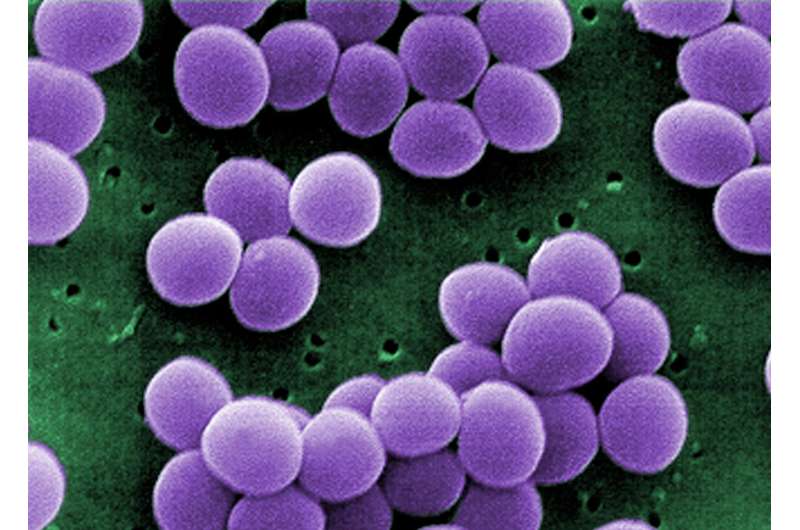Atomic-level motion may drive bacteria's ability to evade immune system defenses

A study from Indiana University has found evidence that extremely small changes in how atoms move in bacterial proteins can play a big role in how these microorganisms function and evolve.
The research, recently published in the Proceedings of the National Academy of Sciences, is a major departure from prevailing views about the evolution of new functions in organisms, which regarded a protein's shape, or "structure," as the most important factor in controlling its activity.
"This study gives us a significant answer to the following question: How do different organisms evolve different functions with proteins whose structures all look essentially the same?" said David Giedroc, Lilly Chemistry Alumni Professor in the IU Bloomington College of Arts and Sciences' Department of Chemistry, who is senior author on the study. "We've found evidence that atomic motions in proteins play a major role in impacting their function."
The study also provides new insights into how microorganisms respond to their host's efforts to limit bacterial infection. Serious bacterial infections in people include severe health-care-associated infections and tuberculosis, both of which have grown increasingly common over the past decade due to rising drug resistance in bacteria. About 480,000 people worldwide develop multidrug-resistant tuberculosis each year, for example, according to the Centers for Disease Control and Prevention.
"What we've shown is atomic-level motional disorder—or entropy—can impact gene transcription to affect the function of proteins in major ways, and that these motions can be 'tuned' evolutionarily," said Daiana A. Capdevila, a postdoctoral researcher in Giedroc's lab, who is first author on the study. "This may allow bacteria to rapidly evolve new ways to overcome medical treatment since atomic motions can be optimized for function more easily than a physical structure."
In the battle between bacterial infection and modern medicine, she said a key step is "mapping" the enemy's territory. Unraveling the molecular structure of proteins that trigger the mechanisms that thwart the human immune system informs the design of new drugs. However, this approach is based on the assumption that a protein's shape fundamentally controls its behavior.
It also assumes proteins are rigid. The new study shows protein function is better understood by studying the structure's internal atomic motion.
"This work is the clearest example thus far of the central and critical role that conformational entropy plays in protein regulation," said Josh Wand, the Benjamin Rush Professor at the University of Pennsylvania's Perelman School of Medicine, who is the author of a commentary paper on the study. "The authors do an impressive array of difficult and intensive experiments to unveil and confirm this conclusion."
Specifically, Giedroc and colleagues analyzed a protein called CzrA that controls how bacteria regulate zinc levels, an important ability that provides microorganisms the power to resist the human immune system. Zinc regulation allows the body to fight off infection by either flooding invaders with zinc, causing cellular death or completely starving them of the element, which also kills infectious agents.
"CzrA controls a biological mechanism in bacteria called the 'zinc pump,' which pushes extra zinc out of bacterial cells in response to the immune system's attempts to poison them with the metal," said Giedroc, whose lab has been studying this process for over 15 years.
Through the use of nuclear magnetic resonance spectroscopy, he and colleagues measured the movement of atoms in CzrA and identified those most affected by zinc. They then "swapped" these atoms out with different amino acids and found that the protein almost completely lost the ability to regulate zinc levels in cells. The experiment revealed unexpected areas on the molecule that appeared to play a role a role in zinc regulation, despite their physically distant location on the protein "map."
"There's no way anyone could have predicted these areas played a role in zinc regulation by simply looking at the protein structure," Giedroc said. "Once you know where these 'hot spots' are located, however, it's theoretically possible to design a small molecule or drug to produce the same effect as our amino acid-swapping experiment—that is, to essentially shut off the protein."
In fact, this is one of the main concepts behind a powerful new class of drugs called "allosteric drugs," so named because they're designed to affect areas on a protein—called allosteric sites—that enhance or regulate the primary function of the protein, such as zinc binding, without directly targeting the part of the protein that controls the primary function.
"This is really about thinking about the functions of proteins in the context of a network—not simply targeting a single strategic point but rather looking at the system holistically," Giedroc said. "And this particular study shows the most effective way to gain this deeper knowledge requires going beyond the molecular level in proteins to understand how atomic motion plays a role in function—after which you can start applying that knowledge to designing more effective drug-based therapies."
More information: Daiana A. Capdevila et al, Entropy redistribution controls allostery in a metalloregulatory protein, Proceedings of the National Academy of Sciences (2017). DOI: 10.1073/pnas.1620665114
Journal information: Proceedings of the National Academy of Sciences
Provided by Indiana University

















